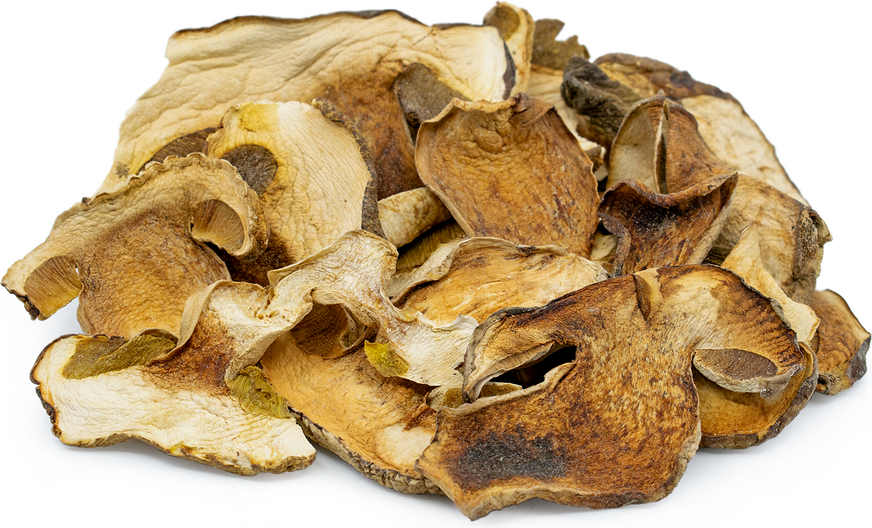


Dried Porcini Mushrooms
Estimated Inventory, lb : 0
Description/Taste
Dried Porcini mushrooms widely vary in size and shape, depending on the size of the fresh mushroom, and generally have a flat and broad appearance with a curved, rounded cap. The mushrooms are preserved in slices, sometimes separating the stems from the caps, and the edges become curled while the surface develops a textured, slightly wrinkled consistency. Dried Porcini mushrooms also range in color from dark brown, light brown, to a rusty, red-brown hue depending on age. Dried Porcini mushrooms have a distinct, smoky, rich, and woodsy aroma. Once reconstituted, the mushrooms acquire a chewy consistency with a dense, meat-like texture, and provide nutty, earthy, and savory, umami-forward flavors. It is important to note that dried mushrooms should be found in large slices, and small, crumbled pieces are a sign of old, flavorless mushrooms.
Seasons/Availability
Dried Porcini mushrooms are available year-round.
Current Facts
Dried Porcini mushrooms, botanically classified as Boletus edulis, are dehydrated, concentrated versions of the fresh wild mushroom belonging to the Boletaceae family. Porcini mushrooms grow individually or in small clusters in forests at the base of pine, fir, hemlock, chestnut, oak, and spruce trees. The thick, domed mushrooms have a symbiotic relationship with the roots of the living trees, and this partnership cannot be recreated in commercial cultivation, resulting in the mushroom remaining wild. Porcini mushrooms also have a notoriously short season, leading chefs and foragers to dry slices of the fresh mushrooms for extended use. Dried Porcini mushrooms are one of the most popular varieties utilized in culinary applications, favored for their robust flavor, dense texture, and woodsy, earthy aroma. Dried mushrooms can be reconstituted and incorporated into a wide variety of applications, and the variety has also become a commercially important export, distributed on a global scale.
Nutritional Value
Dried Porcini mushrooms are an excellent source of iron, a mineral that develops the protein hemoglobin in red blood cells to help transport oxygen. The mushrooms are also a good source of vitamins A and C to strengthen the immune system and reduce inflammation, and the slices contain lower amounts of calcium, potassium, and phosphorus.
Applications
Dried Porcini mushrooms must be reconstituted and can be utilized whole, ground, or infused into a wide variety of culinary applications, adding concentrated, umami flavors. To rehydrate, the dried mushrooms should be soaked in room temperature water for 15 to 30 minutes and then rinsed to remove any excess grit. The ends of the stems may also need to be sliced to remove tough, sandy pieces. Reconstituted Porcini mushrooms can be chopped into soups, stews, gravies, and sauces, including bechamel, tomato, and white, or they can be cooked into eggs, baked into gratins, or simmered into polenta. The mushrooms can also be incorporated into roasted meat dishes such as pot roast, served on top of steaks and fish, or mixed into risottos and pasta. In addition to whole, rehydrated Porcini mushrooms, the dried mushrooms can be ground into a powder and mixed into dough and spice rubs, or the mushrooms can be simmered into olive oil and blended to create flavored oils. Rehydrated mushrooms also produce a flavorful, umami-filled liquid once steeped, and the liquid adds earthy elements to broths, sauces, and soups. Dried Porcini mushrooms pair well with meats such as beef, poultry, veal, duck, and fish, aromatics such as shallots, garlic, and onions, spinach, fennel, arugula, carrots, celery, cheeses such as goat, parmesan, and mozzarella, and herbs such as sage, basil, chives, parsley, and thyme. The dried mushrooms will keep 1 to 2 years when stored in an airtight container in a cool, dry, and dark location.
Ethnic/Cultural Info
Porcini mushrooms are prized in Italian cuisine, and when in season, the mushrooms are celebrated across the country through local food festivals known as sagre. Each sagra is regionally unique and honors the bountiful fall harvests. In the medieval village of Cusano Mutri in the Campania region, a sagra dei funghi or mushroom festival is annually held in the fall, showcasing Porcini mushrooms. The wild variety is commonly found in the forests and natural countryside surrounding the village, and the sagra also features vendors selling local cheeses, wine, and bread to complement the mushrooms. During the festival, Porcini mushrooms are sold dried and fresh, and they are also prepared in cooked applications. One of the festival's traditional dishes is sautéing Porcini mushrooms and layering the slices over melted caciocavallo cheese and toasted bread. Caciocavallo cheese, translating from Italian to mean “cheese on horseback,” is a unique type of cheese tied with a rope and hung in the air to age. Once ready for consumption, the cheese is strung above a warm stove to heat, is scraped when soft, and is spread on the toast with the mushrooms.
Geography/History
Porcini mushrooms are native to regions of the Northern Hemisphere, including parts of Asia, Europe, and North America, and have been growing wild since ancient times. Fresh Porcini mushrooms are only found for a limited season and are considered a delicacy due to their short shelf life. Dried Porcini mushrooms are sliced and dried for year-round use and have a long shelf life, allowing the mushrooms to be shipped around the world. Today Dried Porcini mushrooms are packaged and exported primarily from Asia and are produced on a smaller scale throughout North America and Europe. Dried Porcini mushrooms can be found through online retailers, farmer’s markets, and specialty grocers worldwide.
Recipe Ideas
Recipes that include Dried Porcini Mushrooms. One
| Making Thyme for Health |
|
Vegan Porcini Mushroom Gravy |
| Martha Stewart |
|
Easy Mushroom Gravy |
Podcast




